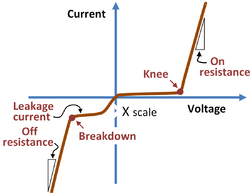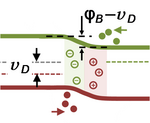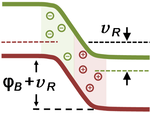Semiconductor diode: Difference between revisions
imported>John R. Brews (→Electrical behavior: cut-in) |
imported>John R. Brews (→Forward bias: footnote & source) |
||
| Line 40: | Line 40: | ||
In bulk material where there are no fields, minority carriers have a very low concentration compared to majority carriers. The minority carriers injected by diffusion tend to increase this population above the equilibrium value, but their population is reduced by ''recombination'' toward the bulk value. Recombination can occur by direct encounter with a majority carrier, annihilating both carriers, or through a ''recombination-generation'' center, a defect that alternately traps holes and electrons, assisting recombination. The minority carriers have a limited ''lifetime'', and this lifetime in turn limits how far they can diffuse from the majority carrier side into the minority carrier side, the so-called ''diffusion length''. | In bulk material where there are no fields, minority carriers have a very low concentration compared to majority carriers. The minority carriers injected by diffusion tend to increase this population above the equilibrium value, but their population is reduced by ''recombination'' toward the bulk value. Recombination can occur by direct encounter with a majority carrier, annihilating both carriers, or through a ''recombination-generation'' center, a defect that alternately traps holes and electrons, assisting recombination. The minority carriers have a limited ''lifetime'', and this lifetime in turn limits how far they can diffuse from the majority carrier side into the minority carrier side, the so-called ''diffusion length''. | ||
In the simple ''pn''-diode the forward current increases exponentially with forward bias voltage, so there is always some current at even very small values of applied voltage. However, if one is interested in some particular current level, it will require a "knee" voltage before that current level is reached. For example, a very common choice in texts about circuits using silicon diodes is ''V<sub>Knee</sub>'' = 0.7 V. Above the knee, of course, the current continues to increase exponentially. Some special diodes, such as some varactors, are designed deliberately to maintain a low current level up to some knee voltage in the forward direction. | In the simple ''pn''-diode the forward current increases exponentially with forward bias voltage, so there is always some current at even very small values of applied voltage. However, if one is interested in some particular current level, it will require a "knee" voltage before that current level is reached. For example, a very common choice in texts about circuits using silicon diodes is ''V<sub>Knee</sub>'' = 0.7 V.<ref name=cut-in> | ||
Naturally, this voltage depends upon the selected current level. In {{cite book |title=Microelectronic circuits |author=AS Sedra and KF Smith |publisher=Oxford University Press |edition=4th |year=1998 |pages=p. 134 & Figure 3.8 |isbn=0195116631 |chapter=Chapter 3: Diodes |url=http://www.amazon.com/Microelectronic-Circuits-Oxford-Electrical-Engineering/dp/0195116631/ref=sr_1_1?s=books&ie=UTF8&qid=1294773658&sr=1-1#reader_0195116631 }} this voltage is taken variously as 0.7 V and 0.5 V. | |||
</ref> Above the knee, of course, the current continues to increase exponentially. Some special diodes, such as some varactors, are designed deliberately to maintain a low current level up to some knee voltage in the forward direction. | |||
===Reverse bias=== | ===Reverse bias=== | ||
Revision as of 13:22, 11 January 2011
A semiconductor diode is a two-terminal device that conducts current in only one direction, made of two or more layers of which at least one is a semiconductor. An example is the pn-diode, made by joining a p-type semiconducting layer to an n-type semiconducting layer.
Electrical behavior
The ideal diode has zero resistance for the forward bias polarity, and infinite resistance (conducts zero current) for the reverse voltage polarity. In other words, the semiconductor diode acts as an electrical rectifier.
The semiconductor diode is not ideal. As shown in the figure, the diode does not conduct appreciably until a nonzero knee voltage (also called the turn-on voltage or the cut-in voltage) is reached. Above this voltage the slope of the current-voltage curve is not infinite (on-resistance is not zero). In the reverse direction the diode conducts a nonzero leakage current (exaggerated by a smaller scale in the figure) and at a sufficiently large reverse voltage below the breakdown voltage the current increases very rapidly with more negative reverse voltages.
As shown in the figure, the on and off resistances are the reciprocal slopes of the current-voltage characteristic at a selected bias point:
Types
Semiconductor diodes come in a large variety of types:
- pn-diode: The pn junction diode consists of an n-type semiconductor joined to a p-type semiconductor.
- Zener diode: The Zener diode is a special type of pn-diode made to operate in the reverse breakdown region, and used often as a voltage regulator. The breakdown voltage in these didoes is sometimes called the Zener voltage. Depending upon the voltage range designed for, the diode may break down by either Zener breakdown, an electron tunneling behavior, or by avalanche breakdown.
- Schottky diode: The Schottky diode is made using a metal such as aluminum or platinum, on a lightly doped semiconductor substrate.
- Tunnel diode: Like the Zener diode, the tunnel diode (or Esaki diode) is made up of heavily doped n- and p-type layers with a very abrupt transition between the two types. Conduction takes place by electron tunneling.
- Light-emitting diode: The light-emitting diode is designed to convert electrical current into light.
- pin-diode: The pin-diode is made of three layers: an intrinsic (undoped) layer between the p- and n-type layers. Because of its rapid switching characteristics it is used in microwave and radio-frequency applications.
- Gunn diode: The Gunn diode is a transferred electron device based upon the Gunn effect in III-V semiconductors, and is used to generate microwave oscillations.
Operation
Here, the operation of the simple pn junction diode is considered. The objective is to explain the various bias regimes in the figure. Operation is described using band-bending diagrams that show how the lowest conduction band energy and the highest valence band energy vary with position inside the diode under various bias conditions.
Zero bias
As shown in the band-banding diagram at the right, when a p-type and an n-type region of the same semiconductor are brought together and the two diode contacts are short-circuited, the Fermi occupancy level is situated at a constant level. This level insures that in the field-free bulk on both sides of the junction the hole and electron occupancies are correct. (So, for example, it is not necessary for an electron to leave the n-side and travel to the p-side through the short circuit to adjust the occupancies.) However, a flat Fermi level requires the bands on the p-type side to move higher than the corresponding bands on the n-type side. Consequently, a region near the junction becomes depleted of both holes and electrons, forming an insulating region with no mobile charges. However, the absence of mobile charge means that mobile charges are not present to compensate for the immobile charge contributed by the dopant ions: a negative charge on the p-type side dues to acceptor dopant and as a positive charge on the n-type side due to donor dopant. The dimensions of this depletion region adjust so the negative acceptor charge on the p-side exactly balances the positive donor charge on the n-side, so there is no electric field outside the depletion region on either side. In this band configuration no voltage is applied and no current flows through the diode. To force current through the diode a forward bias must be applied, as described next.
Forward bias
In forward bias the occupancy level for holes tends to stay at the level of the bulk p-type semiconductor while the occupancy level for electrons follows that for the bulk n--type. A forward bias lowers the separation of the p-type bulk band edges to be closer in energy to those of the n-type, and the two bulk half-occupancy levels are separated by an energy determined by the applied voltage. (The band bending diagram is made in units of volts, so no electron charge appears to convert V to energy.) As shown in the diagram, this reduction in band bending means the depletion region narrows as holes are pushed into it from the p-side and electrons from the n-side. In crossing the depletion layer, the half-occupancy lines for holes and electrons are not flat, and become quasi-Fermi levels that depend upon the current level. In the bulk region on the p-side of the device, the electron half-occupancy line becomes coincident with that of the holes, and vice versa on the n-side.
The electrons in the n-type material are called majority carriers on that side, but any that make it to the p-type side are called minority carriers. The same descriptors apply to holes: they are majority carriers on the p-type side, and minority carriers on the n-type side. From the diagram half-occupancy levels in the depletion region, it is evident that, although the majority carrier densities in this region are reduced compared to the bulk (the band edges bend away from the half-occupancy line), when they cross over the boundary between n-type and p-type to become minority carriers, their concentration far exceeds the value found for minority carriers in the alien bulk material. That is, there are excess minority carriers on the majority-carrier sides of the depletion layer.
With a forward bias a current flows. This current is a diffusion current (that is a current driven by a concentration gradient) of holes across the depletion region from the p-side and of electrons in the opposite direction from the n-side. In the zero bias case there also is a concentration gradient, of course, inasmuch as there are carriers outside the depletion region and none inside. However, there is also an electric field in the depletion region that drives the carriers in the opposite direction to the diffusion. When the forward bias is applied, this electric field is reduced, so the diffusion current dominates and current flows.
In bulk material where there are no fields, minority carriers have a very low concentration compared to majority carriers. The minority carriers injected by diffusion tend to increase this population above the equilibrium value, but their population is reduced by recombination toward the bulk value. Recombination can occur by direct encounter with a majority carrier, annihilating both carriers, or through a recombination-generation center, a defect that alternately traps holes and electrons, assisting recombination. The minority carriers have a limited lifetime, and this lifetime in turn limits how far they can diffuse from the majority carrier side into the minority carrier side, the so-called diffusion length.
In the simple pn-diode the forward current increases exponentially with forward bias voltage, so there is always some current at even very small values of applied voltage. However, if one is interested in some particular current level, it will require a "knee" voltage before that current level is reached. For example, a very common choice in texts about circuits using silicon diodes is VKnee = 0.7 V.[1] Above the knee, of course, the current continues to increase exponentially. Some special diodes, such as some varactors, are designed deliberately to maintain a low current level up to some knee voltage in the forward direction.
Reverse bias
In reverse bias the occupancy level for holes again tends to stay at the level of the bulk p-type semiconductor while the occupancy level for electrons follows that for the bulk n--type. In this case, the p-type bulk band edges are raised relative to the n-type bulk by the applied bias, so the two bulk occupancy levels are separated again by an energy determined by the applied voltage. As shown in the diagram, this behavior means the depletion region widens as holes are pulled away from it on the p-side and electrons on the n-side.
When the reverse bias is applied, the electric field in the depletion region is increased, pulling the electrons and holes further apart than in the zero bias case. Thus, any current that flows is due to the very weak process of carrier generation inside the depletion region due to generation-recombination defects in this region. That very small current is the source of the leakage current under reverse bias.
When the reverse bias becomes very large, reaching the breakdown voltage, the generation process in the depletion region accelerates leading to an avalanche condition which can cause runaway and destroy the diode.
- ↑ Naturally, this voltage depends upon the selected current level. In AS Sedra and KF Smith (1998). “Chapter 3: Diodes”, Microelectronic circuits, 4th. Oxford University Press, p. 134 & Figure 3.8. ISBN 0195116631. this voltage is taken variously as 0.7 V and 0.5 V.




